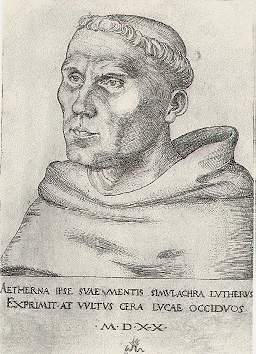





Martin Luther's Life as a Monk (1505-1512)
According to legend (see Lightning), it was during a terrible storm that Luther decided to become a monk. He did not change his mind when his friends and father tried to convince the successful student to continue his law studies. He entered the Augustinian monastery in Erfurt in 1505 and took his monk's vow in 1506.
The life of a monk during Luther's time was hard, and consisted of fasting, prayer and work. A monk's day began at 3 am with the first hourly prayers. This time molded Luther, above all he found a close relationship to the Bible which characterized his later life and work.
 In 1507, Luther was ordained as a priest in Erfurt and started
studying Theology at the University of Erfurt. During his studies, he
came into contact with the ideas of the
Humanists
and embraced their slogan 'Ad Fontes!' - Back to the Source! For Luther
this meant the study of the Bible in its original Hebrew and Greek
(Bible humanism).
In 1507, Luther was ordained as a priest in Erfurt and started
studying Theology at the University of Erfurt. During his studies, he
came into contact with the ideas of the
Humanists
and embraced their slogan 'Ad Fontes!' - Back to the Source! For Luther
this meant the study of the Bible in its original Hebrew and Greek
(Bible humanism).
Martin Luther as Professor in Wittenberg (1512-17)
After recieving his doctorate in Theology in 1512, Luther took a position as Theology Professor at the Wittenberg University 'Leucorea'. He gave lectures over the Psalms (1514-15), Letter to the Romans (1515-16), Letter to the Galatians (1516-17), and Letter to the Hebrews (1517-18).
This time is characterised by Luther's grappling with religious understanding. His decisive religious enlightenment is said to have come during his intensive study of the Letter to the Romans during which time he realized that people receive justice through the grace of God, not through good works: "For in it the righteousness of God is revealed through faith for faith; as it is written, "The one who is righteous will live by faith." (Romans 1:17)
Luther himself stated that he came to this decisive realization in the study room of the Wittenberg monastery. When this actually happened is disputed; it is also known as the Tower experience (Turmerlebenis).
A circle of theologians began to form around Luther, among them Niklaus von Amsdorf and Karlstadt (Andreas Bodenstein).
In 1514 Luther became priest for Wittenberg's City Church.


Remarks, critique, praise to theWebmaster (2002-05-31).